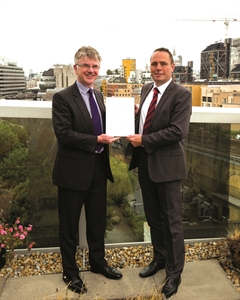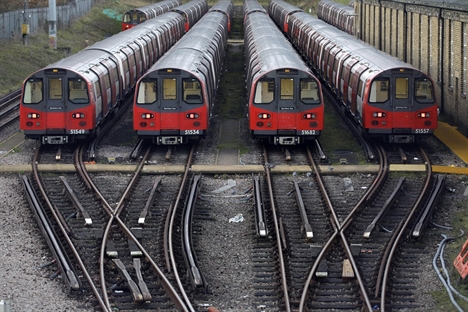01.07.15
World-leading asset management on London Underground
Source: RTM Jun/Jul 15
London Underground is only the second metro in the world to receive the new ISO 55001 accreditation endorsing its asset management systems. RTM heard more from its head of asset strategy and investment, Andy Jinks, and head of asset management Richard Moore.
ISO 55001 is the new international standard for asset management, and builds on the British specification, PAS 55.
London Underground (LU) had held the British certification since 2011, and has now become the first rail authority in Europe – and only the second in the world, after Hong Kong – to achieve the international standard.
 “We’re incredibly proud of that fact,” said Andy Jinks, head of asset strategy and investment at LU. “We’ve been pretty quick off the mark to get this world-renowned accreditation.”
“We’re incredibly proud of that fact,” said Andy Jinks, head of asset strategy and investment at LU. “We’ve been pretty quick off the mark to get this world-renowned accreditation.”
Jinks reiterated the complexity of the LU network and the need to cater for a forecast population of 10 million by 2030.
He said: “We have a combination of old and new assets, with new assets coming on-stream daily, with new trains coming on the District Line and other lines. This doesn’t just happen of its own accord, we have to have intelligent asset management and strategic thought to make sure we balance the old and the new, maintain reliability levels. We’ve had some success in that: we’ve had a 40% improvement in reliability over recent years. And that’s all whilst also planning for growth. So ISO 55001 does, in simple terms, give us an accreditation that says not just farepayers’ but public money is actually spent wisely, and that our asset intelligence is effective and appropriate.”
Maturity assessment
Jinks said LU asked the auditors to give an overall maturity assessment pointing out what areas it should now be concentrating on, and said: “This is a continuous journey; it’s not a situation where we’ve got the certificate and are now happy that we’re ‘good at asset management’.
“We’re working on some things beyond where we are now. They found us to have a high degree of maturity – not just up to the standard but beyond it.”
Asked how happy he is with the overall state of LU asset management, and whether further modernisation is needed, Jinks said: “Managing a highly complex and highly politically charged railway, we’re quite comfortable with where we’ve got to – but to be honest, we’ll never rest on our laurels. We’re continuing with the professionalisation of the asset management role, with a lot of development work and a variety of training courses at various levels – two of which are accredited through the Institute of Asset Management. We’ve also got our competence framework, and we’ve got maturity in our mathematical modelling of asset management for a variety of our assets, which we will continue to grow.”
Richard Moore, head of asset management at LU, told us: “It’s a relatively new discipline, and we’re at the forefront in helping it being developed.”
Envy of the world
Jinks said one key fact helped illustrate the progress that LU has made – a decade ago, it was his team visiting other global metros, utilities and companies to learn from their asset management systems. But now, the world is coming to London.
“Anglian Water, Network Rail, Singapore, Qatar, Sydney, New York – they all want to come and look at some of the advancements we’ve made in asset management. Richard was recently talking at an asset management conference out in Dubai, there’s a lot of interest there.”
LU also routinely shares best practice and does benchmarking exercises with the other metros in the CoMET and Nova international groupings.
Jinks (pictured right, accepting the certificate) said: “Closer to home, Crossrail is part of the TfL estate and will be coming into TfL, and we’re working very closely with our colleagues on that project. Part of my role is looking at not just Underground, but looking at rail as well, and we want to ensure our asset management systems, processes and even some of the data software are common across both Crossrail and Underground to ensure continuity.”
LU is also working with HS2 and Network Rail to share information and best practice on asset management.
New asset management regimes
‘Asset’ is a catch-all term, but in reality covers a vast array of different items of varying size, complexity, longevity and criticality. Indeed, 64p in every £1 spent by LU is for asset maintenance, renewals and upgrades.
“Our strategy is slightly different for each asset,” Jinks said. “We still have a level of time-based and utility-based maintenance regimes, but we are rapidly moving – with new technology and new assets – to a predict-and-prevent regime. A lot of our lifts and escalators now have remote monitoring, as do our electromechanical points. We have daily telemetry that comes off our new 2009 Tube stock and our S Stock trains. We are looking to retrofit some of this telemetry information onto some of our older vehicles.

“We’re very much in the foothills of a predict-and-prevent philosophy. It’s not just about the technology: it’s about the people as well, to make sure we can move to new, smarter regimes. As our assets grow and are updated, we obviously have predict-and-prevent in mind.
‘LU has been running a digital railway for four years’
“One of our interesting challenges – or opportunities – is the rapid convergence of ICT into the traditional railway asset world, not just railway signalling systems but other software systems as well.
“There’s a lot of talk about the ‘digital railway’. Quite frankly, London Underground has been running – albeit without the strapline – a digital railway for around four years.”
He said this applied to everything from the signalling – with TBTC (transmission based train control) on some lines – to the open source timetable information to the maintenance regime, with tablet and mobile device-based track inspections for the last five years.
“The majority of our maintenance is now done on standard scripts, on portable devices,” Jinks said. “Most of our fleet are now using that technology, again linking straight into our asset management systems.”
He noted that at stations and on the gateline, customer service staff are increasingly armed with mobile devices too. “It’s not just in the maintenance world – we are digitising all of our operations,” he said.
Moore said LU is “agnostic” on the issue of pushing for global cross-industry standards. “We’re pretty self-contained in many ways. However, we do have the opportunity to share data and we do that very effectively through the use of BIM, more and more so. We have a requirement by 2016 to have implemented that.
“We operate closely with our suppliers and contractors to make sure that we supply and transfer data effectively. Whether that requires one single standard across industry – we’re agnostic on that at the moment. We’re certainly not pushing in that direction.”
Modelling
LU is also seeking to understand the whole-life costs of its assets to make better decisions, both civils assets that can last for decades and electro-mechanical systems.
“We’ve also got some very complex best-in-class track asset modelling capability, which has had a lot of attention from around the world.
“Where we’re trying to invest some time now is in our fleet – again, in the electrical systems. A lot of our fleet decision-making on new trains is because of capacity, not necessarily from a condition or reliability perspective.
“We aim to understand the best whole-life cost position, knowing consciously if we decide to do something differently, we understand the consequences of moving away. It may be that the best thing from a whole-life cost perspective is not practical or affordable or deliverable. We’ve been growing our modelling and maturity over the last seven or eight years to get there.”
Moore added: “An important aspect is knowing the right time to replace and refurbish, as well as what you replace it with. When you are a long-term infrastructure maintainer and owner, both the macro project-scale but also some of the smaller decisions – which still amount to hundreds of thousands of pounds – year-in, year-out, they are all opportunities to ensure we’re doing the right thing and getting the best value across the whole life cycle.”
Jinks added that much of LU’s whole-life cost modelling capability has been developed in-house. “We’ve dabbled with the market, and where appropriate we’ve partnered with the market, but a lot of the fundamental philosophy and the detail in our models is something we developed ourselves and then improved through software systems.”
LU’s current asset management strategy dates from 2013, but is due for an update this calendar year – not least to reflect the new reality as regards the resignalling of the sub-surface lines, new thinking on ICT, and the approach to station overhauls having shifted to place greater focus on their look and feel.
Keeping it up
The ISO 55001 accreditation lasts for three years, with check-up audits after six months and then yearly. Moore said: “They are a chance for the auditors to ensure we’re still making progress, and for us to show where we are on our maturity path.
“It’s an indication of our commitment to asset management, and it gives confidence to our customers and supply chain and our industry partners – all of our stakeholders – that we’ve got the standards in place to make informed decisions.
“It also gives confidence to our staff, from the frontline to the chief executive of the business, so people can see how they fit in with the overall system. Somebody who’s maintaining an asset on the frontline, or is in a depot – they can understand how they fit into the overall asset management system, and that we’re all working together with the overall aim of improving services for customers and the reliability of the railway.
“With a comprehensive spending review [on its way], it’s very important that we can demonstrate to everybody at the Department for Transport that we have been internationally recognised as being able to spend the money that was given from the government in an efficient and effective way.”